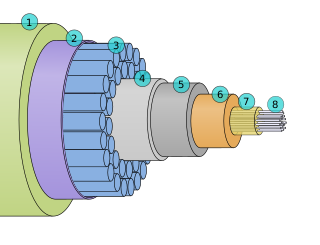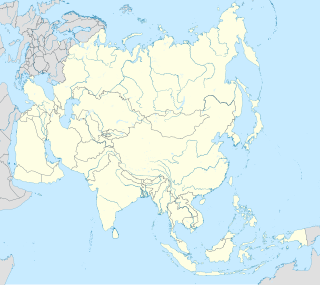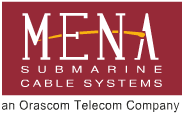Related Research Articles

The TomahawkLand Attack Missile (TLAM) is a long-range, all-weather, jet-powered, subsonic cruise missile that is primarily used by the United States Navy and Royal Navy in ship- and submarine-based land-attack operations.

A submarine communications cable is a cable laid on the sea bed between land-based stations to carry telecommunication signals across stretches of ocean and sea. The first submarine communications cables laid beginning in the 1850s carried telegraphy traffic, establishing the first instant telecommunications links between continents, such as the first transatlantic telegraph cable which became operational on 16 August 1858. Subsequent generations of cables carried telephone traffic, then data communications traffic. Modern cables use optical fibre technology to carry digital data, which includes telephone, Internet and private data traffic.

A submarine power cable is a transmission cable for carrying electric power below the surface of the water. These are called "submarine" because they usually carry electric power beneath salt water but it is also possible to use submarine power cables beneath fresh water. Examples of the latter exist that connect the mainland with large islands in the St. Lawrence River.
Fibre-optic Link Around the Globe (FLAG) is a 28,000-kilometre-long fibre optic mostly-submarine communications cable that connects the United Kingdom, Japan, India, and many places in between. The cable is operated by Global Cloud Xchange, a subsidiary of RCOM. The system runs from the eastern coast of North America to Japan. Its Europe-Asia segment was the fourth longest cable in the world in 2008.
SEA-ME-WE3 or South-East Asia - Middle East - Western Europe 3 is an optical submarine telecommunications cable linking those regions and is the longest in the world. Completed in late 2000, it is led by France Telecom and China Telecom, and is administered by Singtel, a telecommunications operator owned by the Government of Singapore. The Consortium is formed by 92 other investors from the telecom industry. It was commissioned in March 2000.

South East Asia–Middle East–Western Europe 4 is an optical fibre submarine communications cable system that carries telecommunications between Singapore, Malaysia, Thailand, Bangladesh, India, Sri Lanka, Pakistan, United Arab Emirates, Saudi Arabia, Sudan, Egypt, Italy, Tunisia, Algeria and France. It is intended to be a complement to, rather than a replacement for, the SEA-ME-WE 3 cable.

GO p.l.c. is a Maltese integrated telecommunications company. It is a quadruple play provider that offers local and long distance telephone services, wireless services, digital terrestrial television, DSL and Fiber to the home internet access. GO is based in Marsa, Malta.
TEAMS is an initiative spearheaded by the government of Kenya to link the country to the rest of the world through a submarine fibre optic cable. It was first proposed as an alternative to EASSy, the East African Submarine Cable System. The Kenyan government had grown frustrated with the ownership model favoured by South Africa, the time it was taking and what it perceived as an attempt by South Africa to control the cable. As a result, in November 2006, the Kenyan government decided to partner with the Emirates Telecommunication Establishment (Etisalat) to build its own fibre optic cable.

The 2008 submarine cable disruptions were three separate incidents of major damage to submarine optical communication cables around the world. The first incident caused damage involving up to five high-speed Internet submarine communications cables in the Mediterranean Sea and Middle East from 23 January to 4 February 2008, causing internet disruptions and slowdowns for users in the Middle East and India. The incident called into doubt the safety of the undersea portion of the Internet cable system.

I-ME-WE is a 13,000-kilometre (8,100 mi) submarine communications cable system between India and France. The design capacity is 3.84 Terabits per second. It has been operational since 2009 with Tripoli, Lebanon being connected in November 2011. Internet Service Providers and Network Operators hope to utilize the additional bandwidth to support high-bandwidth peer-to-peer IP-based broadband services such as multimedia streaming, broadband Internet and voice/video telephony.
BERYTAR is a submarine telecommunications cable system in the Mediterranean Sea linking Syria and Lebanon.
UGARIT is a submarine telecommunications cable system in the Mediterranean Sea linking Cyprus and Syria.
GO-1 is a submarine communications cable system that links Sicily to Malta, operated by the Maltese telecommunications company GO.
Europe India Gateway (EIG) is a submarine communications cable system that connects the U.K., Portugal, Gibraltar, Monaco, France, Libya, Egypt, Saudi Arabia, Djibouti, Oman, United Arab Emirates, and India.

Middle East North Africa (MENA) is a submarine communications cable system that is planned to connect Italy, Greece, Egypt, Saudi Arabia, Oman, and India. It will be about 9,000 kilometres (5,600 mi) long and is planned to deliver up to 5.76 terabits per second.

Bangladesh Submarine Cable Company Limited (BSCCL) is a fiber optic submarine cable telecommunications company and telecommunications service provider based in Bangladesh. Emerging in July 2008 BSCCL presently handles Bangladesh's two submarine cables as a member of the SEA-ME-WE 4 and SEA-ME-WE 5 international submarine cable consortiums. SEA-ME-WE4 cable runs a total length of 18,800 km through 17 landing points in Singapore, Malaysia, Thailand, Bangladesh, India, Sri Lanka, Pakistan, United Arab Emirates, Saudi Arabia, Egypt, Tunisia, Italy, Algeria and France.
TE North is a submarine telecommunications cable linking France and Egypt developed by Alcatel-Lucent. The cable system is 3,100 km long with a capacity of up to 1.28 Tbit/s over 8 fibre pairs. The cable system expands the service footprint of the existing TE transit corridor by offering additional transit services in the Mediterranean. The cable was launched in 2010 and was later upgraded to use 40G channels in the summer of 2011, becoming the first cable in the Mediterranean to use this technology. The cable has landing points in:
- Marseille, Bouches-du-Rhône, France
- Abu Talat, Alexandria Governorate, Egypt
Content from the United States diplomatic cables leak has depicted the United States' opinion of the Middle East-related subjects extensively. WikiLeaks has published these classified documents, diplomatic cables, between the United States Department of State and its diplomatic missions around the world. Many previously unknown statements or opinions about a variety of Middle Eastern topics have been revealed.
The CS Chamarel, originally CS Vercors was a cable layer owned by France Telecom Marine, laying submarine communications cables around the world. It was built in 1974 and destroyed by a fire in August 2012. As the Vercors, the ship laid cables on and between all continents except Antarctica, including numerous trans-Atlantic cables and the first ever Israeli-made cable, and set the record for the deepest submarine buried cable lay in 2000. The ship was badly damaged by a fire in August 2012.
References
- 1 2 "Egypt - Syria Fibre Optic Submarine cable Aletar". Archived from the original on 2009-01-07. Retrieved 2008-10-14.CS1 maint: bot: original URL status unknown (link)